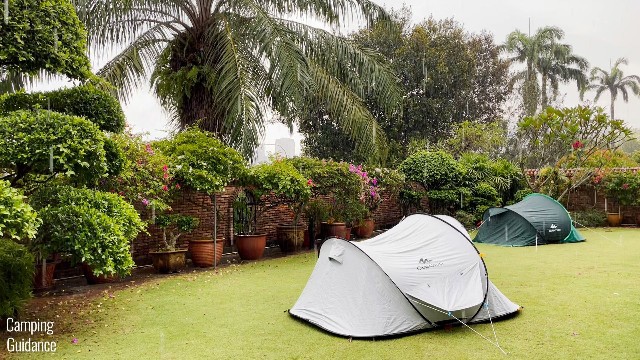What Are Pop Up Tents Made Of? (5 Answered Questions!)
This page contains affiliate links, and that means that I may earn a commission if you buy something, at no extra cost to you. You can find my full disclosure policy here.
Over the past 4 years, I’ve bought and tested several pop up tents, including the quality of the materials used. Here’s everything I’ve discovered about what pop up tents are made of.
Generally, a pop up tent’s poles are made of fiberglass, the pop up tent flooring is made of either polyester or polyethylene, and the tent body and rainfly are usually made of polyester with a waterproof coating.

However, there can be small differences in the quality and type of material used. I’ll explain it all to you in this blog post.
What is the Structure of a Pop Up Tent?
Every camping pop up tent is made of 4 main parts – the tent poles, the flooring, the tent body, and the rainfly.
The tent poles of a pop up tent are what give the tent its classic “pop up” motion. These tent poles have the ability to store lots of pole tension, and are extremely flexible. They also hold the tent body up, allowing pop up tents to be freestanding tents.
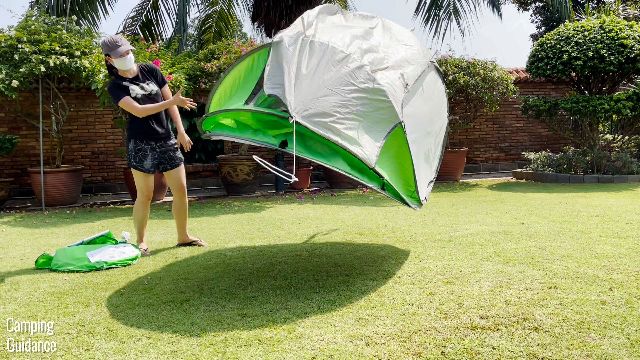
The flooring of a pop up tent may or may not be the same material as the rest of the tent’s body. Generally, the flooring of a tent should be the most rugged part of a tent, as it comes in constant contact with the ground.
The rest of the pop up tent’s body is usually made of polyester, and may or may not include a certain amount of mesh for ventilation. The more mesh a pop up tent body has, the more ventilation it allows.

The rainfly of a pop up tent may be full coverage, or partial coverage. The main purpose of a pop up tent’s rainfly is to protect the pop up tent from as much rain as possible.
Related Reading: What is a Pop Up Tent, and How Does it Work?
Related Reading: 16 Pros and Cons of Pop Up Tents
What Are Pop Up Tent Poles Made Of?
A pop up tent’s poles are always made of fiberglass. This is because fiberglass is a lot more flexible than aluminum, steel, or other materials, which is needed when popping open and folding up pop up tents. Fiberglass is also durable, allowing it to withstand some pole tension and stress.
Pole Material
Every single one of my 7 pop up tents have poles made of fiberglass:
| Pop Up Tent | Pole Material |
|---|---|
| Teton Sports 1-Person Vista Quick Tent | Fiberglass |
| Teton Sports 2-Person Vista Quick Tent | Fiberglass |
| Coleman 2-Person Pop Up Tent | Fiberglass |
| Fresh and Black 2-Person Tent | Fiberglass |
| Quechua 2 Seconds 2-Person Tent | Fiberglass |
| Fresh and Black 3-Person Tent | Fiberglass |
| Coleman 4-Person Pop Up Tent | Fiberglass |
As pop up tents have poles that are pre-attached, the poles need to be flexible and easily bent, in order to be packed up. Since fiberglass is a flexible material, it allows the pop up tent to be twisted and folded up easily. Other materials like aluminum and steel cannot be bent, and thus cannot be used in pop up tents.

Pole Thickness
The thickness of a pop up tent’s poles also depends on how they need to be folded when packing up. The thinner the fiberglass pole, the more flexibility the pole allows.
I found that my Coleman Pop Up Tents and Quechua 2 Seconds Tents need to be folded and bent more (into a circle), and thus the fiberglass poles of these tents tend to be thinner for more flexibility.
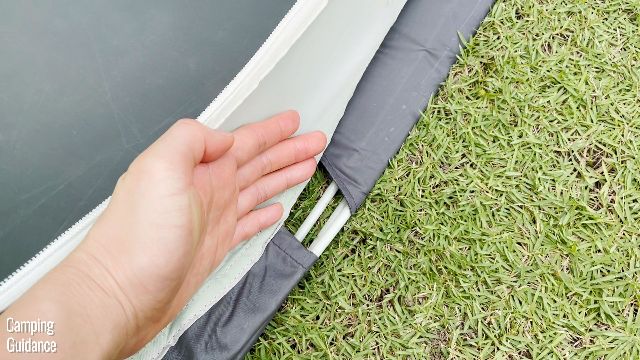
In contrast, my Teton Sports Quick Tents fold up more like an instant tent, rather than a pop up tent. As such, less flexibility is needed in the fold up, and I found my Quick Tents to have slightly thicker fiberglass poles.

Pole Durability
Due to the thin fiberglass poles, pop up tents are infamously known as being less durable than regular tents, and I’ve found that this is generally true.
Nevertheless, all of my pop up tents have lasted me many years. I’ve been using pop up tents for 4 years now, and my older pop up tent (the Quechua 2 Seconds Fresh and Black Tent) is still going strong, even though the poles are thin as well.

One of the poles popped out of the joint on my last set up though, but thankfully I managed to pop it back in. It still works!
Related Reading: Do Pop Up Tents Have Poles?
Related Reading: How Long do Pop Up Tents Last?
What is a Pop Up Tent’s Flooring Made Of?
A pop up tent’s flooring is usually made from either polyethylene or polyester, much like regular camping tents. Some pop up tents have additional material running up the sides of the pop up tent, creating a bathtub feature for added waterproofing.
Flooring Material
I found that my Coleman Pop Up Tents and Teton Sports Quick Tents have flooring made of polyester, while my Quechua 2 Seconds Tents have flooring made of polyethylene:
| Pop Up Tent | Flooring Material |
|---|---|
| Teton Sports 1-Person Vista Quick Tent | 75D 190T Polyester |
| Teton Sports 2-Person Vista Quick Tent | 75D 190T Polyester |
| Coleman 2-Person Pop Up Tent | 185T 68D Polyester |
| Fresh and Black 2-Person Tent | Polyethylene |
| Quechua 2 Seconds 2-Person Tent | Polyethylene |
| Fresh and Black 3-Person Tent | Polyethylene |
| Coleman 4-Person Pop Up Tent | 185T 68D Polyester |
Generally, the higher the Denier rating of the polyester, the thicker and more durable the polyester. For example, my Teton Sports has flooring made of 75D Polyester, which is thicker and more durable than the flooring of my Coleman Pop Up Tents, which are made of 68D Polyester.

Nevertheless, I still found the flooring of my Teton Sports Quick Tents to be fairly thin. I do wish that they were made of at least 150D polyester. After my heavy rain test, I noticed that the flooring looked damp, and would probably leak soon.

My flooring material of choice is polyethylene, which is usually more rugged and can take more of a beating. All of my Quechua 2 Seconds Tents, both the Regular and Fresh and Black versions, are made of 100% polyethylene, which look like this:

I found these to be thicker, more rugged, and let less water in (so better waterproofing).
Bathtub Flooring
In addition, some of my pop up tents have bathtub floorings, which others do not.
| Pop Up Tent | Bathtub Feature? | Height of Bathtub |
|---|---|---|
| Teton Sports 1-Person Vista Quick Tent | No | – |
| Teton Sports 2-Person Vista Quick Tent | Yes | 5 inches |
| Coleman 2-Person Pop Up Tent | No | – |
| Fresh and Black 2-Person Tent | Yes | 5 inches |
| Quechua 2 Seconds 2-Person Tent | Yes | 5 inches |
| Fresh and Black 3-Person Tent | Yes | 5 inches |
| Coleman 4-Person Pop Up Tent | No | – |
A pop up tent has a bathtub feature when the flooring of the tent extends up the edges of the tent, and look like this:
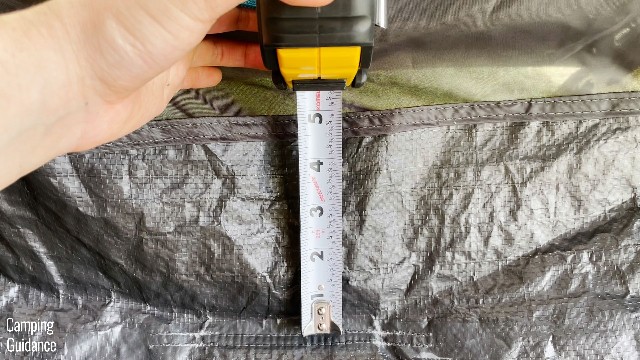
The main purpose of this is to prevent water from leaking into the tent through the seam between the flooring and the tent body, especially in locations where flooring is prone to occur. For example, if there’s flooding outside of up to 3 inches, and your bathtub flooring extends up to 5 inches high, water technically cannot enter your tent through the flooring.

This is an important waterproofing feature that cannot be self-manufacturered/made, so I tend to prefer tents with bathtub features, rather than those without.
Related Reading: Are Pop Up Tents Good in Rain?
Related Reading: Are Pop Up Tents Good in Wind?
What is a Pop Up Tent Body Made Of?
A pop up tent’s body is typically made of some combination of polyester, as well as mesh. The thickness of the polyester is measured using the Denier rating, while the quality of the mesh depends on the size of the mesh’s holes.
Tent Body Material
The most common material for tent bodies is polyester, and all of my 7 pop up tents are made of polyester as well:
| Pop Up Tent | Tent Body Material |
|---|---|
| Teton Sports 1-Person Vista Quick Tent | 75D 190T Polyester |
| Teton Sports 2-Person Vista Quick Tent | 75D 190T Polyester |
| Coleman 2-Person Pop Up Tent | 185T 68D Polyester |
| Fresh and Black 2-Person Tent | Polyester |
| Quechua 2 Seconds 2-Person Tent | Polyester |
| Fresh and Black 3-Person Tent | Polyester |
| Coleman 4-Person Pop Up Tent | 185T 68D Polyester |

Similar to the material of the pop up tent’s flooring above, the higher the Denier Rating of the polyester, the thicker and more durable it is. As such, my Teton Sports Quick Tents are thicker and more durable than my Coleman Pop Up Tents in tent body material.

On top of that, I usually like to know the Denier rating as well as the Thread count of the polyester; this usually inspires confidence. On the other hand, just marketing your tent as being made of “polyester” doesn’t quite inspire the same confidence.
However, because I’ve used Decathlon products for a long time, I decided to take a chance on the Quechua 2 Seconds Tents.
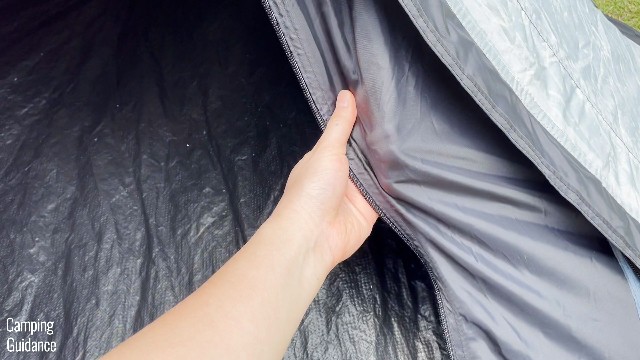
The tent body material of the Quechua 2 Seconds Tents felt (to me, at least) to be around 68D to 75D polyester as well, and I had no issues with it.
Mesh Material
There are also significant differences in the quality of the mesh used in each pop up tent:
| Pop Up Tent | Mesh Material |
|---|---|
| Teton Sports 1-Person Vista Quick Tent | No-see-um |
| Teton Sports 2-Person Vista Quick Tent | No-see-um |
| Coleman 2-Person Pop Up Tent | Regular |
| Fresh and Black 2-Person Tent | Regular |
| Quechua 2 Seconds 2-Person Tent | Regular |
| Fresh and Black 3-Person Tent | Regular |
| Coleman 4-Person Pop Up Tent | Regular |
Most tents have regular mesh, while higher quality tents tend to be made of no-see-um mesh. The difference between both mesh materials is the size of the holes.

While no-see-um mesh can keep out the smallest of bugs (including no-see-ums, of course), regular mesh can only keep out bigger bugs, like mosquitoes. Regular mesh will not be able to keep out no-see-ums.
As such, before going camping, check the location to see what kind of bugs are prevalent in that area. If there are no no-see-ums or other small bugs, you can get away with regular mesh.

Also, no-see-um mesh is much smoother and softer on the hands, while regular mesh is not as smooth. I found my Teton Sports Quick Tents to be the highest quality in terms of mesh, with no-see-um mesh, while my other pop up tents only had regular mesh.

What is a Pop Up Tent’s Rainfly Made Of?
Rainfly Material
Most of my camping tents have rainflies made of polyester as well, and my pop up tents were no different. Sometimes, the rainflies might have a slightly higher Denier rating than the tent body (as a rainfly has to be durable), but this is not always the case.
| Pop Up Tent | Rainfly Material |
|---|---|
| Teton Sports 1-Person Vista Quick Tent | 75D 190T Polyester |
| Teton Sports 2-Person Vista Quick Tent | 75D 190T Polyester |
| Coleman 2-Person Pop Up Tent | 185T 68D Polyester |
| Fresh and Black 2-Person Tent | Polyester |
| Quechua 2 Seconds 2-Person Tent | Polyester |
| Fresh and Black 3-Person Tent | Polyester |
| Coleman 4-Person Pop Up Tent | 185T 68D Polyester |
As for all my pop up tents, the rainfly material was exactly the same as the tent body material.

Rainfly Coverage
Apart from the rainfly material, one important feature to look out for is the amount of coverage that the rainfly provides. As a general rule, full coverage rainflies provide much better rain protection than partial coverage rainflies.
| Pop Up Tent | Rainfly Coverage |
|---|---|
| Teton Sports 1-Person Vista Quick Tent | Almost full coverage |
| Teton Sports 2-Person Vista Quick Tent | Almost full coverage |
| Coleman 2-Person Pop Up Tent | Partial coverage |
| Fresh and Black 2-Person Tent | Full coverage |
| Quechua 2 Seconds 2-Person Tent | Full coverage |
| Fresh and Black 3-Person Tent | Full coverage |
| Coleman 4-Person Pop Up Tent | Partial coverage |
My Coleman Pop Up Tents had the least rainfly coverage, with the rainfly only covering the mesh at the top of the tent.
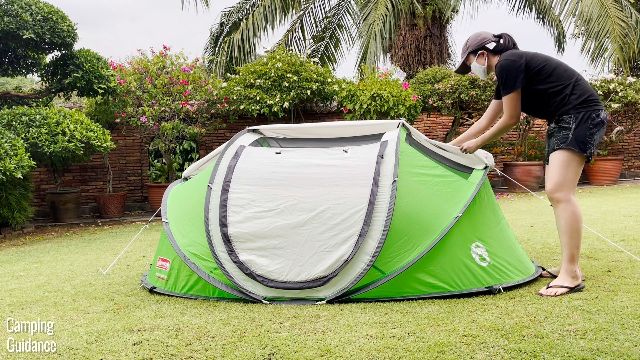
This, coupled with the fact that the rainfly is made of the thinnest polyester, gave the Coleman Pop Up Tent poor rain protection. The entire tent was dripping wet after just 15 minutes of heavy rain.

My Teton Sports Vista Quick Tents had almost full coverage rainflies, but there was a 2-inch gap between the bottom of the rainfly and the ground. Nevertheless, it was still able to stand up to 1 hour of heavy rain.

My Quechua 2 Seconds Tent had 100% full coverage rainflies, which made them super rain resistant. I put my regular Quechua 2 Seconds Tent through 3 days of heavy rain, and it protected the inner tent body from getting wet, with absolutely no leaks at all.
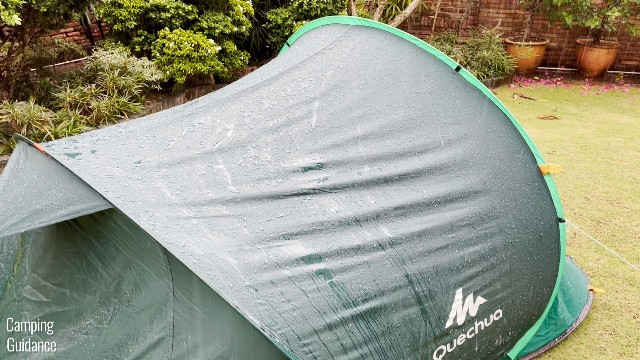
Apart from just looking at the materials used in a pop up tent, there are plenty of other factors to consider, such as ease of use, spaciousness, features, and more. I covered everything in this blog post right here, where I bought, tested and compared 7 different pop up tents.

| Pop Up Tent | Full Review | Check Price |
|---|---|---|
| Teton Sports 2-Person Vista Quick Tent | Read Review | Amazon, Moosejaw |
| Teton Sports 1-Person Vista Quick Tent | Read Review | Amazon, Moosejaw |
| Coleman 4-Person Pop Up Tent | Read Review | Amazon, Moosejaw |
| Coleman 2-Person Pop Up Tent | Read Review | Amazon, Moosejaw |
| Quechua 2 Seconds 2-Person Tent | Read Review | Decathlon |
| Quechua 2 Seconds Fresh and Black 2-Person Tent | Read Review | Decathlon |
| Quechua 2 Seconds Fresh and Black 3-Person Tent | Read Review | Decathlon |
All My Pop Up Tent Resources:
